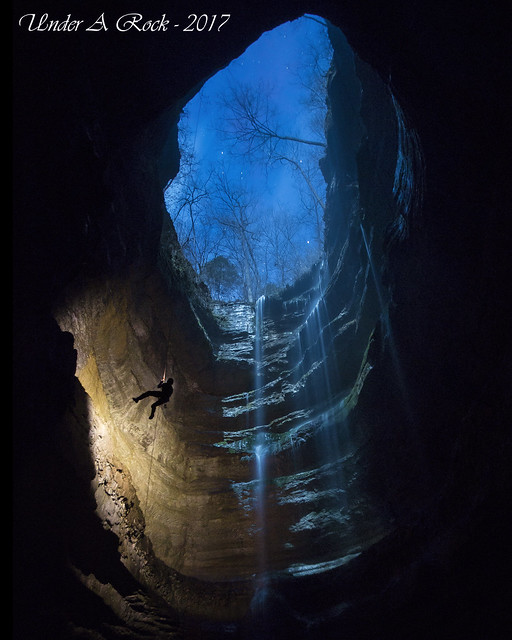Located within the heart of TAG country, Neversink is the classic Alabama open air pit.
 |
| Deirdre Conroy in Neversink at the height of summer, August 2016. |
Neversink is, for many, one of the most beautiful open air pits in the United States. Not much can beat sunbeams shooting through the fog of a muggy summer morning, making rainbows in the waterfalls, and causing the moss and fern to glow a bright emerald. The cave was the first acquisition of the Southeastern Cave Conservancy (SCCi), and as of April 2017 is owned and managed by them as an open access preserve in Jackson County, AL. For full directions and access, please see the SCCi website.
Getting to the cave begins with a short but steep hike. Coming from the bottom of the mountain, one must cross through part of the Monteagle Limestone and then almost all of the Bangor Limestone to reach the cave. The total elevation gain is around 200ft. A quarter of the way up the hill (roughly) is a barely noticeable shelf with lots of black rock in a thin but distinct layer: this is the Hartselle Sandstone, and is the contact between the Bangor and Monteagle. The bottom of Neversink is at this contact. As you near the pit, specifically the elevation of the pit, the Bangor Limestone begins to exhibit large chunks of chert - signifying the you are nearing the upper limits of the Bangor and are almost to the Pennington Limestone. In fact, you'll pass through this chert layer in the first ten or fifteen feet of the pit. You will also see the Hartselle at the bottom.
The top of Neversink itself is located at the extreme upper level of the Bangor. Opposite the main rig points, on the north side of the pit, water rolls out of a spring emerging from the base of the Pennington and cascades in multiple streams down the shaft.
 |
| Emily Deaver and late-winter waterfalls, as seen from the primary rig point. Spring 2016 |
Neversink Pit is about 162ft from both rig points, the top is roughly 40ft by 80ft and the bottom is about 60ft by 200ft. From the primary rig point, one looks roughly NW across the pit. In this direction the pit significantly bells out. Across the SW-NE plane, the pit bells, but not nearly as much. The pit is ringed by multiple ledges, which in the spring and summer are covered in thick vegetation including an endemic fern. In late summer, a efflorescent fungus glows under the ledges.
Deirdre Conroy ascends under the glow of the moon, March 2017.
 | |
| Moonlit nights in the winter seasons are a great time to do the pit. |
Of the two rig points, I have found that the rig on the east side of the pit is more enjoyable, though the lip can be frustrating. Decades of heavy use have left this lip incredibly smooth (I have never padded it) and crossing it can be come a problem because of the lack of traction. Below the lip, one stays within a few feet of the wall before it gradually bells away. About 80ft off the floor the main chamber is encountered and one is out in the middle of the big room.
The second rig point is closer to the wall, but the lip is far easier, and is in fact much like a set of stairs. I have also never padded this lip.
Both rig points have well-placed bolts. Do not rig to anything else.
The bottom of the pit is often very wet and muddy. In the summer lots of animals (mainly reptiles and amphibians) can be found, including venomous snakes. In wet seasons the waterfalls make a lot of spray and the bottom of the pit can be rather chilly and damp.
Visits
March 2014 - with Cassandra Mosley, Andrew Mengele, Gretchen Poffenbarger, and Lauren Ponza. Dropped camera bag down the pit - destroyed lots of stuff.
March 2016 - with Cassandra Mosley, Andrew Mengele, Elliot Guerra-Blackmer, among others
August 2016 - first summer trip - with Deirdre Conroy, Amy Skowronski, Shawn Hogbin, and Ed Villareal
March 2017 - finally got the moonlit shot! with Eric Lee Hahn and Deirdre Conroy.
Visits
March 2014 - with Cassandra Mosley, Andrew Mengele, Gretchen Poffenbarger, and Lauren Ponza. Dropped camera bag down the pit - destroyed lots of stuff.
March 2016 - with Cassandra Mosley, Andrew Mengele, Elliot Guerra-Blackmer, among others
August 2016 - first summer trip - with Deirdre Conroy, Amy Skowronski, Shawn Hogbin, and Ed Villareal
March 2017 - finally got the moonlit shot! with Eric Lee Hahn and Deirdre Conroy.
No comments:
Post a Comment